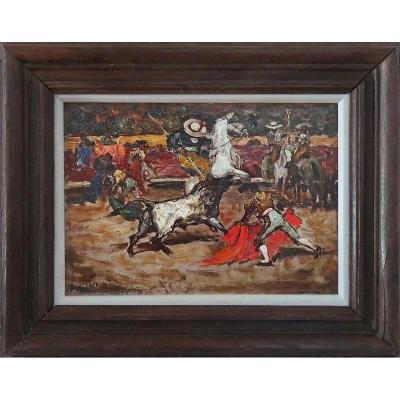Using small touches, neo-impressionist style, the painter plays on variations of green and black, in contrast with the whites, and creates a strong composition. Splitting its sheet in two across the entire width, it depicts a farm facade overlooking a large spit of meadow. A goose, in a corner, enlivens the layout.
From this intensely chromatic work, a sweet and intimate nostalgia emerges.
Jaroslav Panùska was born in 1872 in Horovice, and died in 1958 in Kochanov in Czechoslovakia.
Son of a surveyor, he studied art at the Prague Academy with Julius Marak.
Marak wanted his students to understand the charms of nature and had to represent it, unvarnished, in the most authentic way.
The work had to provide emotion, by restoring the “soul” and the simple beauty of a landscape.
Jaroslav Panùska was one of the best representatives of this teaching throughout his artistic life.
His first period, until 1910, was symbolist, dominated by themes inspired by Czech tales, often linked to death, solitude and the supernatural.
He subsequently devoted himself to representing the landscapes of Czechia, Slovenia and the seaside in Dalmatia.
“His works equal the paintings of the best Czech landscape artists”
From 1923 until his death in 1958, he lived in Kochanov, part of Svêtlà nad Sàzavou.
Most of Panùska's paintings have entered private collections or public museums such as the National Gallery in Prague.
Gouache on paper, in perfect condition, signed “Jaroslav Panùska” at the bottom center.
Size: 9,8 x 12,6 Inches without frame and 13,8 x 16,7 Inches with black lacquered wooden frame with copper border.


















![C27-original Gouache-signed-auguste Gérardin-messe-[georges V]-1928](https://www.proantic.com/galerie/home-decor/img/small/1237495-main-6567097fbf195.jpg)





 Le Magazine de PROANTIC
Le Magazine de PROANTIC TRÉSORS Magazine
TRÉSORS Magazine Rivista Artiquariato
Rivista Artiquariato
